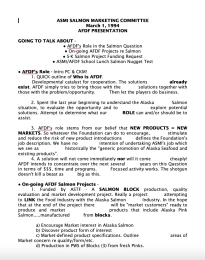Summary
The purpose of this report is to present our work on an improved commercial crab boat offloading system. This is a solution to a problem presented to us by Garret Evridge and Taylor Holshouser from Alaska Ocean Cluster.
Covered here is a summary of the entire design process and an in depth presentation of our final design proposal. The problem we were presented with was to improve upon the existing system of offloading commercial crabbing vessels by speeding it up and minimizing deal loss to the crab being offloaded. The constraints for this project were largely dependent on the approach we took to solving the problem. We wanted to make sure that the existing process for catching crab did not need to be changed, meaning that our system would have to be either separate from the vessel or out of the way of work on the deck while crabbing. While we had no specific budget, a system that was cost effective and marketable to the industry was required. Our initial design concepts focused on drastically decreasing offload times by modifying crabbing vessel holds to allow crab to be filled directly into brailer bags that could then be lifted out. This approach was by far the most efficient one we looked at in terms of offload times, however, the associated time and monetary costs to implement and maintain such a system led us to deem the concept unfeasible for this problem.
The other broad concept idea was a system that was separate from the vessel and thus could be used on multiple boats without requiring each one to be retrofitted. This option entails a less drastic deviation from the existing process which leads to a smaller decrease in offload times but also much lower costs. Ultimately the decision was made to take this approach to the problem. We designed a conveyor belt system to move crab in the hold to the hatch and then up and out of the hatch to be brought to the processor. Our design is twofold, with the main focus of our design being on a framework that could lower a conveyor belt down into the hold as grab are offloaded. The second aspect of our system is modular conveyor belt sections that can be laid out in the hold leading into the vertical conveyor belt which allow workers to offload crab more efficiently as they need only to be placed onto a nearby conveyor belt to be offloaded. The vertical conveyor belt assembly is designed to weigh less than 1 ton as this is roughly the capacity of many of the cranes available to move it. The modular sections are designed to be roughly 35 lbs each making them portable by hand.
Also included are future ideas and changes that would likely need to be pursued in order to successfully implement this system. What we present here is what we believe to be a viable concept for improving the crab offloading process. While it is not likely that a usable system will look exactly like what we have presented here, we believe that the overall form and functionality of the system is in accordance with the problem presented.



